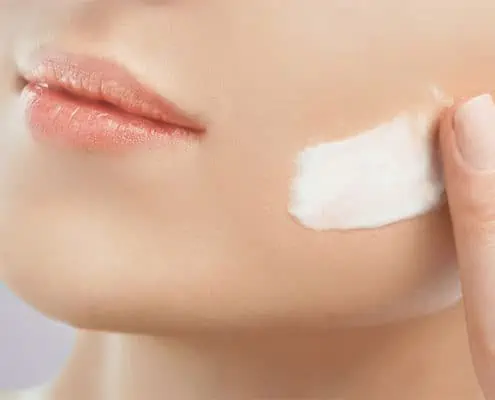
OC 949-428-4500
LA 310-460-2444

If we deliver Alpha Lipoic Acid to damaged skin will it help it?
Every so often the airwaves fill with news about a new miracle substance that can cause skin tightening and make your skin young again, as if you magically had a neck lift or non-surgical face lift.
Some of these substances are synthetic but most are compounds discovered from some sort of natural source, like a rare melon that is grown only in France or an even rarer orchid found only in a mysterious jungle somewhere. Of course, the more rare the plant, the more expensive the product, which only increases the hype about it.
Most of these substances are animated by the marketing hype about them, which points to the unfortunate fact that few, if any, of them actually undergo serious scientific research and clinical testing. Most are like a flash in the pan, and as the media hype-wave passes, the substance recedes from memory in perfect timing with the arrival of the next new miracle substance promising miracle skin rejuvenation.
Alpha Lipoic acid is a naturally occurring substance found in many plants and animals and is also produced in our human bodies. It has many important biochemical roles in human physiology and is found in every single cell in our bodies.
Some of the roles include:

Alpha Lipoic acid is a powerful antioxidant that participates in many different physiological functions.
As we all know, oxidative damage also prematurely ages our skin, causing wrinkling, thinning and skin cancers. Thus, anything that enhances our skin’s ability to fight oxidative damage, will also increase its heath, supporting skin tightening and skin rejuvenation.
Alpha Lipoic Acid is now commonly used as an “integrative oncology” IV therapy for various cancers with remarkable results, including pancreatic cancer. The general medical establishment is quite negative about such out-of-the-box treatments, but associated clinical studies are solid, and no sane person can argue with the results.
For this article, our point is clear: If ALA can help heal a patient with cancer, it certainly cannot hurt to use it for aging damaged skin, with wrinkles, jowls, acne, cystic acne or perhaps rosacea.
It has a critical role as a “co-factor” in the generation of energy in every single cell.
More and more, in skincare clinics such as ours who practice advanced Integrative Medicine, IV therapy is becoming an integral and critical component of effective protocols for overall health and wellbeing, including that of the skin.
Every cell in the body must generate its own energy. Our bodies are NOT engineered like our neighborhoods, where a central power station feeds (supplies) each of our homes. Every home must have its own energy generator.

Mitochondria are small “organelles” that exist inside each of our cells.
Every cell uses the same physiological “machine” to generate energy called Mitochondria. Mitochondria are small “organelles” that exist inside each of our cells. Within each mitochondria, the primary biochemical pathway that converts food into energy that the cell can use is called the Citric Acid Cycle. Thus, carbohydrates and fats are converted into the molecule “ATP” which is the primary chemical “fuel” that cells use to live and function. Alpha Lipoic Acid is a key component in this pathway. Without Alpha Lipoic Acid the cycle would stop, our cells would not be able to produce energy to function (ATP), the cell would die and shortly thereafter so would we.
This applies to all the different types of cells that comprise the skin as well. If each of them is not fully functioning at the level of their mitochondria, the skin will deteriorate, prematurely age, wrinkle, sag, and become more susceptible to cancer. On the other hand, treatments that energize the mitochondria of skin cells, will cause skin tightening, lifting, toning, and overall skin rejuvenation. Such treatments should be combined with laser skin tightening, non-surgical facelift, skin resurfacing, neck lift, and any other protocol that is integrative in nature.
Ozone is known to energize mitochondria in a direct and profound way. Though the scientific explanation goes beyond the scope of this article, I will address ozone in a forthcoming article. For now know, that mitochondrial stimulation is the reason that our protocols combine ozone with CIA. (Collagen Induction Acupuncture).
Alpha Lipoic Acid has mild anti-inflammatory properties.
Ever seen severely sun damaged skin? Is there any doubt in your mind that it is chronically inflamed? Thus, it is easy to see why Alpha Lipoic Acid benefits sun-damaged skin and is expected to have a profoundly curative anti-inflammatory effect on the skin
Alpha Lipoic Acid may have a positive “anti-aging” effect by inhibiting “cross bridging”.
Lastly, Alpha Lipoic Acid can help our bodies remove toxic heavy metals.
Our bodies naturally use specific metals as a healthy and necessary part of our physiology. Copper, iron, zinc, manganese, chromium, molybdenum and selenium are found in small quantities (referred to as “trace” elements) as important components of certain molecules. A well-known example is the critical presence of iron in our hemoglobin.
However, other metals, usually classified as “heavy metals” such as lead, mercury, cadmium and aluminum are toxic to us and do not play a role in our physiologies. When somehow we absorb them, they are not only toxic but hard to get rid of as well. For example mercury that you inadvertently absorbed as a child, will remain in your body for life, causing toxic damage the entire time.

The process of getting rid of toxic heavy metals is called “chelation”.
Biochemically speaking, the foreign heavy metal is bound to another molecule that the body can process through a filtering mechanism. The body does this naturally but only to a limited extent. Essentially, the foreign toxic heavy metal that the body doesn’t handle well, is “hitched” or “chelated” to a naturally occurring healthy molecule that the body is designed to handle… and the good molecule tows the toxic metal molecule through a filtering process that eliminates it through the urine or feces.
When a person is carrying a significant heavy metal load, their body will need help in getting rid of it. In such cases, Chelation Therapy, wherein the patient takes therapeutic amounts of these healthy chelating compounds, either orally and/or through IV therapy, in order to detoxify from the toxic heavy metals.

The matter of solubility is a key factor. For instance, sugar and salt dissolve easily in water, but neither of them will dissolve in oil.
One of the reasons that Alpha Lipoic Acid benefits our physiology and has so many roles is its unusual property of being soluble in both fat and water. This unusual characteristic is called: “amphiphilic”.
One of the reasons that Alpha Lipoic Acid benefits our physiology and has so many roles is its unusual property of being soluble in both fat and water. This unusual characteristic is called: “amphiphilic”.
When it comes to the biochemistry of animal physiology, the matter of solubility is a key factor. As we know from our experience in the kitchen, some substances can be dissolved in water and others only in oil. For instance, sugar and salt dissolve easily in water, but neither of them will dissolve in oil. On the other hand butter will not dissolve in water, but does dissolve in fat or oil.

In fact everybody knows that “oil and water don’t mix”, which means that they do not dissolve in each other. Therefore it stands to reason that a substance that dissolves in one of them will not dissolve in the other. An exception to this would be an amphiphilic compound such as Alpha Lipoic Acid which dissolves in both.
The reason properties of solubility are important is because animal physiology can be divided into two primary internal environments;
Thus, physiologically active chemicals such as vitamins that need to function in a water (hydrous) environment need to be water soluble, whereas vitamins that need to function in a fat (lipid) environment need to be fat soluble.
By the way, solubility is also a critically important consideration of the design of medications and their proper prescription. For example, to be effective as a drug that fights a bladder infection it must be water soluble in order to collect and be active in the urine, whereas a drug that is engineered for breast tissue will need to be lipid soluble, as breast tissue is predominantly composed of lipids.

Now that we know a few of the benefits of Alpha Lipoic Acid, is it good for our skin?
There are a number of conditions for which ALA supplements have proven beneficial.
Now that we know a few of the benefits of Alpha Lipoic Acid, the reason for this article is to address whether or not it can be good for our skin as either a topical or oral product.
Obviously all the different types of cells that we have in our skin benefit from what Alpha Lipoic Acid does for all cells. (Functions 1-5 listed above) So the critical question becomes, if we deliver Alpha Lipoic Acid to damaged skin will it help it? Theoretically, it should help… but does it?

Unfortunately, this is precisely where much medical science falls short. Many things we think we understand about our physiology that lead us to developing a particular therapy or product that according to our ‘theories’ should work, don’t work when clinically tested.
Often times even substances that work when tested on cell cultures in a laboratory setting, do not work when tested on living beings. Worse yet, sometimes our theoretical therapies actually cause damage.
The truth is, that as much as we think we understand about our physiology, we are barely scratching the surface of its actual complexity.
Indeed, every individual element of human physiology is complicated, and when millions of these elements are combined into a single interrelated, exquisitely balanced, complete and synergistic system… and then integrated into all the other dimensions of life that are beyond physiology… we end up with beings that are infinitely complex.
I am not the first to say such a thing… but exploring the “inner engineering” of human physiology is like touching the mind of God.
In the case of Alpha Lipoic Acid and its benefits, some clinical testing has been conducted with encouraging, but not conclusive results.
Topical products containing Alpha Lipoic Acid have reduced fine lines and wrinkles to various extents. However, much more clinical testing is needed before a definitive conclusion about the efficacy of Alpha Lipoic Acid can be reached. This can also be said about treating acne, cystic acne, rosacea, sun damaged skin, age spots and sun spots.
The good news is, that evidence does exist that Alpha Lipoic Acid benefits the skin and can help, and we know that it can’t hurt you. This alone is progress when compared to other popular products that can cause irritation and even damage when overused such as Tretinoin (Retin-A, Renova), especially for people who are hypersensitive to it.
One last point. Should you choose to use Alpha Lipoic Acid products, make sure that the product uses the ‘R’ form of Alpha Lipoic Acid, which is more effective than the ‘S’ form.
Doctors Alice Pien, MD and Asher Milgrom, Phd are established pioneers in the fields of Regenerative Medicine and Skincare. Their expertise ranges from advanced laser systems to HCT/P – Stem Cell medicine. Their medical education and advanced certifications span from medical schools of NY State University, the University of Chicago, to Johns Hopkins, Harvard and UCLA. They approach medicine with the clinical expertise of over 85,000 successful treatments over the past 20 years and significant scientific research resulting in proprietary protocols that they customize for each individual patient.
AMA Regenerative Medicine & Skincare | 1570 Brookhollow Dr., Santa Ana, CA 92705 | 6310 San Vicente Blvd STE 285, Los Angeles, CA, 90048 | Privacy Policy